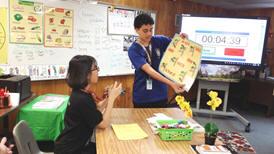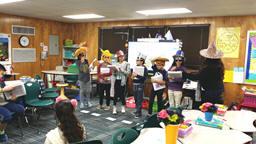
New Arrival Centers, “NAC,” a program in Cypress-Fairbanks Independent
School District (CFISD) in Houston, Texas, strategically provides accelerated language instruction to students who move to Texas from all over the world;
who exhibit minimal English upon enrollment; yet who demonstrate remarkable proficiency achievements as a result of this one-year program.
Vision
The vision statement of CFISD is “Learn. Empower. Achieve. Dream. LEAD.”
NAC brings this vision to fruition by covering all of its aspects.
-
- NAC students learn English rapidly in this thoughtfully designed program that is proven to accelerate their acquisition of the language.
- NAC empowers students by equipping them with the knowledge and skills needed to function successfully in the American school setting.
- NAC students achieve academically and socially as they gain confidence and quickly reach parity with their English-speaking peers, showing graduation rates higher than the general population.
- NAC students can attain the American dream with English enhancing their opportunity to achieve success and prosperity through hard work, determination, and initiative.
- NAC graduates are leaders in their homes and communities.

Need and History
When students who don’t speak English immigrate to the United States, they often have difficulty adjusting to the American public school experience. Federal Home-language Surveys show that almost 100 languages/dialects are spoken in CFISD. Although the district operates a thriving English as a Second Language (ESL) program at all levels, along with a comprehensive Spanish bilingual program at the elementary level, NAC takes these ideas even further, addressing 16 languages at present. CFISD leaders have recognized that recent immigrants—those just beginning to learn basic, functional English—could make greater academic progress if provided a specialized setting, along with specially trained teachers, to accelerate their language acquisition.
CFISD developed the NAC program in response to rapid growth and dramatic demographic shifts, which have yielded an increase in the district’s population of students new to the United States.
A 2012 study by Rice University showed that Houston has surpassed Los Angeles and New York City to become the most ethnically diverse metropolitan area in the U.S. As CFISD residents are a component of these figures, the district has been observing this trend for several years. Federal Home-language Surveys show that almost 100 languages/dialects are spoken in CFISD. Although the district operates a thriving English as a Second Language (ESL) program at all levels, along with a comprehensive Spanish bilingual program at the elementary level, NAC takes these ideas a step further.
Purpose
CFISD leaders recognized that recent immigrants—those just beginning to learn basic, functional English—could make greater academic progress if provided a specialized setting, along with specially trained teachers, to accelerate their language acquisition. The key purpose of NAC is to increase English fluency.
Timeline of implementation
CFISD launched the NAC program in 2006. Over time, the successful model has been expanded to include a wider range of grade levels and a greater number of sites. NAC teachers receive special training during district professional-development days, and they benefit from curriculum and coaching support provided from the central office. Students receive the targeted instructional program over the course of one school year. At the culmination of each year, an inspiring “NAC Celebration” ceremony celebrates students’ successful exit from the program.
Current CISD set up
| Characteristics | Elementary | Middle School | High School |
| Number of Campuses in CFISD (as of 2019) | 56 | 18 | 12 |
| Number of NAC Sites | 3 | 5 | 5 |
| Grades | 4-5 | 6-8 | 9-12 |
| Time in NAC Program | 1 year | 1st semester NAC
2nd semester ESL NAC |
1st semester NAC
2nd semester ESL NAC |
| Integration with General Population | NAC students attend regular classes for Music, Art, and PE. | NAC students are scheduled into regular classes for non-core subjects such as PE and electives. | |
The following aspects of the NAC setup are true regardless of level:
-
- Classes are loaded with a maximum of 15 students per teacher.
- The program serves all languages.
- Students who enroll in NAC have spent 0-6 months in U.S. schools.
- After the one-year NAC program, students return to their neighborhood school’s ESL program.
- All NAC teachers have ESL certification as part of their credentials.
- Each NAC teacher receives a $1500/year stipend.
Activities
In recent years, CFISD has increased its emphasis on differentiated instruction, and development of NAC is another expression of this approach to identifying and meeting students’ needs. NAC students work on making a transition from social language to academic language—for example, comprehending a science teacher’s lesson is a different listening experience than understanding a TV sitcom. Because learning to speak a new language is fraught with potential for embarrassment from difficulties related to pronunciation, vocabulary, syntactic differences, etc., NAC teachers have a heightened awareness of the need to create and maintain a risk-free environment in which students feel comfortable as they venture into these linguistic challenges. Instruction is fast-paced, varied, fun, and motivating.
With immediate immersion, NAC students begin to speak, read, and write English during the very first week of school. Course content is integrated so that students learn English while mastering target academic areas. Using brain-based strategies, teachers integrate the content to include reading improvement, public speaking, language, grammar and usage skills, social studies, and U.S. history.


Accelerated Learning: NAC’s curriculum incorporates the theory of Accelerated Learning in all of its lessons. This proven instructional model provides a positive learning environment, total learner involvement, collaboration among learners, variety that appeals to all learning styles, and contextual learning.
Particularly important to make recent immigrants feel comfortable and confident, a crucial aspect of NAC is to provide a nonthreatening learning environment. To create a warm atmosphere that welcomes the students to the NAC, the teacher should remove intimidation, thereby lowering the affective filter and creating a rapport among students and teachers.
NAC classrooms are structured for success. They do not look like regular classrooms. Flowers are placed on each table, and tables are arranged in a semicircle, which brings the teacher closer to the students. This setup helps create an emotional connection. From the students’ view, as they look around the room, posters are strategically placed for unconscious learning.
-
- The right side of the room shows future learning.
- The center of the room is current learning.
- The left side of the room displays past learning posters.
- A landscape painting (with no words or man-made structures) is displayed prominently in the front of the classroom for students to view as they listen to the readings.
The NAC Lesson Cycle (teacher overview)
The lesson cycle is not organized in terms of days, but as a series of six phases. The Introduction, Active Concert, and Passive Concert phases are always together. Plan the instructional schedule so that you have enough time to do all three together without interruption. Transition among the three parts is silent with no movement or talking.
-
-
- Introduction: The Introduction phase is when you tell a personal story. Set the stage and present the big picture by providing concise information. Present key concepts. Relate new information to known information. During this time students will share ideas by way of volunteering, which gives the reluctant students time to gain confidence.
- Active Concert Presentation: The Active Concert follows the Introduction, and these phases are never divided. This phase is solemn and dignified. The teacher stands and reads while music from the Classical period plays in the background.
-
Your voice is never monotone. Your words surf the music. When the music stops, you stop. Fluctuation of intonation provokes expectancy. The students are seated in a semi-circle in front of you. They read along and highlight any words they do not understand. The use of classical music promotes a state of relaxed awareness. Music carries emotions, which helps connect to their learning.
-
-
- Passive Concert Presentation: The Passive Concert follows the Active Concert, and these two concerts are never divided. During this session the teacher sits and reads while music from the Baroque period plays in the background. Read with normal conversational intonation. Students remain seated in front of you in a semicircle. Texts are placed under their chairs, and they focus on the rhythm and pronunciation of the language.
- Primary Activation: The teacher presents information. Choral reading takes place with the teacher listening and students reading together. Different voices and intonation are used for the various characters in the story. The highlighted text indicates when everyone should stand up. Brain research tells us that movement helps to keep students engaged.
-
The teacher then invites students to participate in role-play while reading the story. Students use props and hats. This process provokes emotional meaning for the students.
You will have to model this behavior for the students. Don’t be put off by students who may make a face at the silliness—if they have a sense of humor and will laugh with you, then they will go along with the putting on the hats and role-playing. There are always students who may not cooperate. It is up to you to send the message that students who do cooperate will receive the attention. While students are reading, the teacher stands behind students giving support and positive feedback. The teacher never corrects pronunciation while students are reading in front of the class. Then the teacher reviews vocabulary that the students have highlighted as being unfamiliar. The teacher explains the words by demonstrating the meaning, drawing pictures, and/or writing short definitions for the students to copy.
-
-
- Primary/Secondary Activation: Students are using the new information in games, songs, chants, and conversation pieces. The idea is that we want our students to feel successful. This is the time when many language arts skills are practiced.
- Secondary Activation: Activities are more unguided as students demonstrate that they can fully understand the concepts that have been taught.
-
Every cycle is finished with a culminating activity—a story, a poem, a play, etc. Students create their own stories or plays and present them to the class. Students who are reluctant to perform are not forced. But we have found by the third and fourth day students want to participate. In a supportive environment that is warm, caring, and encouraging to the students, students can blossom.

Resources Strategies/Materials Site
Teaching with the Brain in Mind
use of Classical and Baroque music, use of stand-and-stretch activities www.jensenlearning.com Altis Rapid Mastery Newcomers Programs
posters, flash cards, games, props, textbooks, workbooks, songbooks, etc. www.altisrapidmastery.com
Audiences Served
Students in the Cypress-Fairbanks NAC program are enrollees new to CFISD who are identified as recent immigrants having little to no English language skills. NAC enrollment criteria include the following:
-
- Immigrant student
- 0-6 months in a U.S. school
- Non-English speaker or very limited English speaker
- Commitment to attend summer school
- Parent permission to participate in the NAC
Personnel
In addition to the front-line teaching staff of 36 teachers assisted by 14 paraprofessionals), the district budget supports two central-office NAC curriculum facilitators who work with teachers, students, and parents to ensure success. NAC is overseen by CFISD’s Director of Curriculum and Instruction for Special Populations.
For the NAC program, teachers are hired through the district’s usual job-application procedure handled through Human Resources. As central-office interviewers screen candidates, they look for teachers who have demonstrated sustained success with the ESL population of students. A rookie teacher is generally not considered a good fit for a NAC position.
CFISD provides an annual three-day session of focused training on the special NAC Lesson Cycle as described above. For ongoing professional development, NAC teachers from across the district convene for Share Sessions 4-5 times throughout the school year to discuss instructional strategies, to dialog about successes and struggles, and to seek feedback from colleagues. This group of educators operates as a Professional Learning Community.
Families
Though not “learners” in the sense of being enrolled students, the parents and siblings of NAC students also benefit from special “customer service” and guidance as teachers and curriculum facilitators show them how to navigate the procedures of a U.S. school system and help them gain awareness of American cultural and social expectations.
Parents
Although CFISD offers ESL classes for parents, such programs are not specifically designed for the NAC subset. All parents needing to improve their English skills (or needing to become better-acquainted with procedures in US schools) are invited to attend. Aside from the end-of-year NAC Celebration event that most parents attend, parents are encouraged to be involved in student activities that occur at the campus. A campus that is a NAC site has staff who are empathetic to these parents and has experience with making NAC parents feel welcome—a good foundation before the family transitions back to their neighborhood school to continue parent involvement at that campus long-term.
Community
The project encourages and evidences civic awareness and engagement. The existing community engages with new immigrants: A 2012 study by Rice University showed that Houston had surpassed Los Angeles and New York City to become the most ethnically diverse metropolitan area in the U.S. Generally, Houstonians tend to have a high sense of civic awareness regarding immigrants, accompanied by a high level of responsiveness to this influx of the workforce. While many areas of the USA have experienced severe recession in recent times, Harris County has continued economic growth. As a school district, CFISD has observed population trends for decades, and the CFISD community encourages new immigrants learn how to engage in American life:
Successful Impact
The goal of NAC is to increase each student’s language proficiency in English. Success toward this goal is measured as progress undergoes reliable, valid assessment using a state-required reading test called the Texas English Language Proficiency Assessment System (TELPAS). The TELPAS includes listening, speaking, writing and reading. By the end of their first year in U.S. schools, NAC students typically score as Intermediate or Advanced rather than Beginner. Among NAC students in CFISD, generally 80% have made 1+ levels of progress, while about 50% have made 2+ levels of progress.
The demonstrated results of Cypress-Fairbanks ISD’s New Arrival Centers are tangible in many ways.
-
- Enrollment: Having expanded to all levels—elementary, middle school, and high school—the NAC program serves students in grades 4-12. Since its beginning in 2006, NAC has served over 5,000 students. CFISD expects to serve about 500 students in NAC during the 2018-19 school year.
- Sites: Dedicated classrooms operate at 13 campuses. CFISD’s Transportation Department provides shuttle service to NAC students from the district’s 86 home campuses.
- Time: NAC students’ schedules reveal a thoughtful mix of language-intensive blocks of instruction along with a manageable load of elective classes, promoting familiarity with the regular school setting. Students exit the program after one year.
- Materials and Training: The custom curriculum has been honed over time to a high level of effectiveness, and the teachers receive extensive professional development and support for implementation.
The success of NAC is also evidenced by recognition of the program itself.
-
- CFISD’s NAC initiative continues to serve as a model that other districts seek to emulate. Over the years, dozens of site visits—by educators ranging from neighboring districts to foreign countries—have been conducted to acquaint others with the organization, staffing, professional development, scheduling, and curriculum implemented for CFISD’s successful program.
- The American School Board Journal acknowledged the success of NAC when it named CFISD an honorable mention recipient in its 2013 Magna Awards program.
- The Texas Association for Bilingual Education (TABE) named Pamela Broussard as its 2013 Bilingual/ESL Secondary Teacher of the Year. The NAC teacher at Cypress Falls High School said, “To watch students go from uprooted, to culture shock, to replanted, to growing, to thriving, is an exciting process. It is rewarding to be a part of a student’s hopes and dreams.” Her outlook epitomizes the NAC teaching staff.
- Selecting CFISD in its Districts of Distinction program, District Administration magazine featured “New Arrival Centers—Get the NAC!” among its 2015 honorees.
- In 2019, the Goldin Foundation for Excellence in Education selected NAC as a recipient of its Exemplary Projects award.
Replication and/or Adaptation: Establish Your Own NAC
Sharing NAC
In addition to welcoming numerous site visitors, the program has enjoyed a keen level of interest from the district’s own Board. As trustees take time to visit campuses, they often seek out the NAC classrooms to observe the life-changing program and express their support to its teachers. The CFISD Board of Trustees has been highly involved in educating others about the program, offering NAC as a model of success to be replicated.
The following is a list of venues that included NAC presentations by a team of CFISD administrators and Board Trustees:
(1) the annual joint conference of the Texas Association of School Administrators and Texas Association of School Boards, considered the state’s premier education-related convention,
(2) Celebrating Educational Opportunities for Students of All Cultures, a collaborative effort among the school board associations of TX, AZ, CA, and NM,
(3) meeting of the Gulf Coast Area Association of School Boards, and
(4) the National School Boards Association conference.
The Birth of NAC: Steps in CFISD’s Process
This list of project milestones can inform districts considering a similar initiative.
NAC Pamphlet
This 4”x6” overview handout has accompanied presentations given by Dr. Macias.
Contact
Maria Trejo, Director of Curriculum & Instruction for Special Populations
281-517-6387
Maria.Trejo@CFISD.net
Dr. Linda Macias, Associate Superintendent for Curriculum & Instruction and Accountability
281-897-4118
Linda.Macias@CFISD.net
